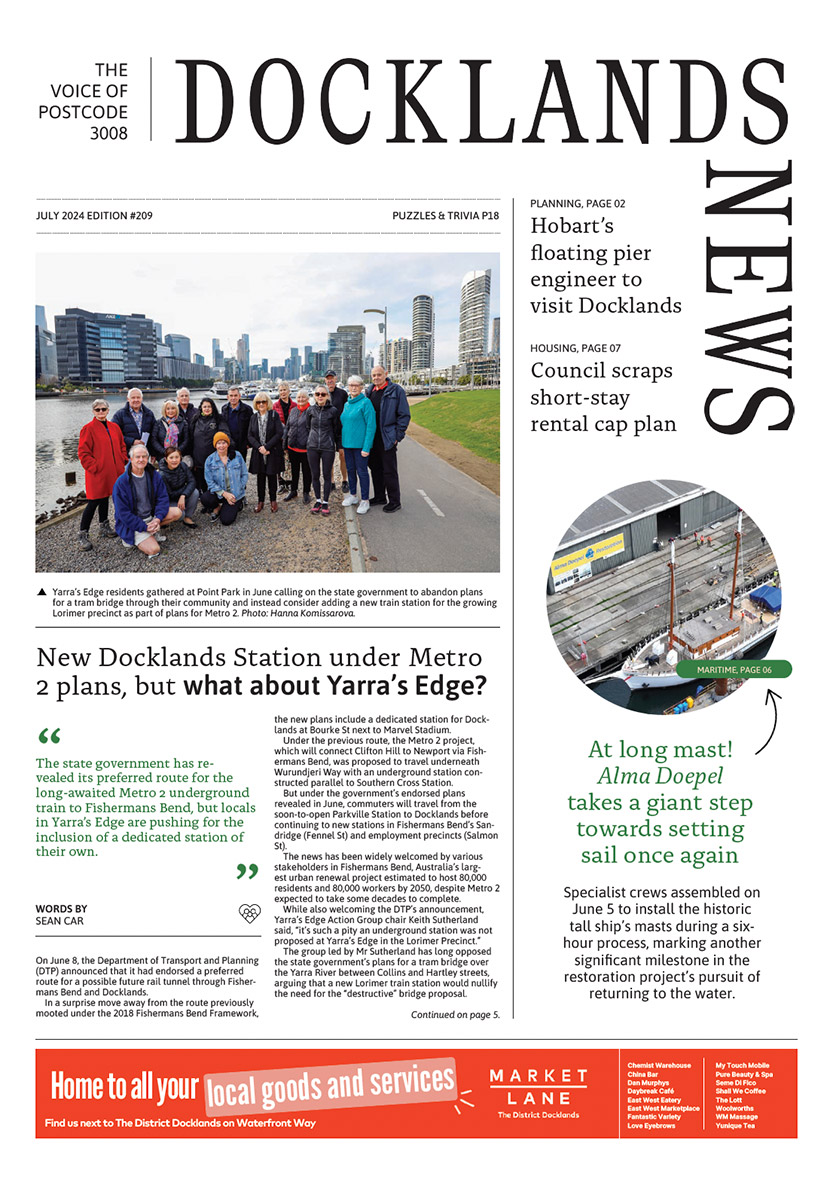A gateway to the docks
By Ashley Smith - Royal Historical Society of Victoria
If you were a cart or lorry driver delivering or picking up goods during the 1920s, this concrete gate adorned with the Melbourne Harbour Trust crest would be your last barrier before entering Victoria Dock.
There were two sets of Customs gates. This set of gates was located on Cowper St, now known as Harbour Esplanade (west of Marvel Stadium). The picture is cited by multiple sources as the gate near the corner of Cowper and Piggot streets, now located where the Esplanade meets up with the Bourke St extension. The second gate was located at the corner of Pitt St, which is now swallowed up by NewQuay Promenade. These gates were erected around 1927 and housed watchmen who monitored the traffic and cargo that came and went through the docks.
For as long as there have been ports, wharves or docks, there have been opportunistic thieves who have taken advantage of unwatched cargo, and Melbourne was no exception. The Argus in 1918 (August 21) identified that stolen items ranged from beer, condensed milk, medicine, tin, meat and women’s wear. At Victoria Dock, the Harbour Trust attempted to combat the problem by installing watchmen, and then replaced their own patrol team with a police patrol in 1913. However, with each passing year there was an increase in prosecutions and convictions, rising from 36 and 30 respectively in 1913, to 127 and 117 in 1920. Some of the workers on the wharves were accused of having criminal records, and others used their jobs to exploit some extra cash. A report from the Dookie and Katamite Recorder (February 26, 1920) reported a carrier who was caught stealing tinplate as he was “short a couple of bob”. After stolen oilcloths and women’s shoes were found at his home, he received a combined seven-month stint behind bars.
In a 1920 report in The Herald (October 23), the Watchmen leader, Mr. P Wade, speculated that there was “an organised gang at work”, with the head acting as “the financial man and brains”. Wade went on to add that gangs would usually target cargo in the daytime, using hooks to open bales, then the goods would be hidden and smuggled out by boat in the dead of night. Regardless how much of his speculation was fact, shipowners were spending thousands on preventative measures, while the Harbour Trust paid the police more than £3000 a year for their wharf duties.
Pilfering from wharves became such a nation-wide issue that in 1921 a Royal Commission was put together to investigate the matter. In Melbourne alone, it was found that shipowners, insurance companies and railway authorities paid pilfering claims worth more than £100,000 a year. Goods were found to be stolen before being shipped to Australia or during the voyage (the contents of crates would be replaced with rubbish to give the illusion of weight) as well as within Melbourne’s ports and before inspections at warehouses. The commission also made suggestions to quash the threat altogether, ranging from the closing of sheds during meal hours, and increased surveillance, and to install lighting and fences around the docks.
The Harbour Trust would soon give more attention to the dock’s security. In 1921, the police unit was expanded from 12 to 26 people to increase dock surveillance. Construction projects later in the decade also helped to discourage thieves, with the dusty Cowper Street Road being reconstructed, and a 15-foot-high wall built alongside to enclose the whole dock area. The wooden customs houses were moved to new locations, and newer, concrete customs houses were built. The construction of fencing in the docks required around 126 linear feet (38m) of steel gates, 1531 feet (467m) of reinforced concrete wall and 610 feet (185 m) of galvanised iron. That’s not to say their problems disappeared altogether when the gates opened. Newspapers continued to report arrests of dock thieves into the 1930s, and the roadways along the gates were prone to becoming gluepots of mud that damaged lorries and other vehicles. Despite these issues, the gates would remain a feature of the docks for nearly six decades
Curiously, a year after the gates opened in 1927, the walls would find another use as a protective barrier during the waterside workers strikes (see last month’s article in Docklands News). According to The Herald (September 21, 1928) during the strikes, the dock’s No.3 shed was prepared to temporarily accommodate 800 volunteers, to avoid any violent beatings from irate strikers. The walls and gates would allow volunteers to freely “work without fear of intimidation”.
Today, with the dock no longer a site of industry and trade, there are no longer any walls or fences or gates needed. Instead, when one walks by Marvel Stadium to see the Esplanade, they are treated to the wide expanse of the docks, and the many parked boats. The only security needed now is to prevent anyone trespassing on the deteriorating Central Pier, but that’s a story for another time … •

New Docklands Station under Metro 2 plans, but what about Yarra’s Edge?





 Download the Latest Edition
Download the Latest Edition